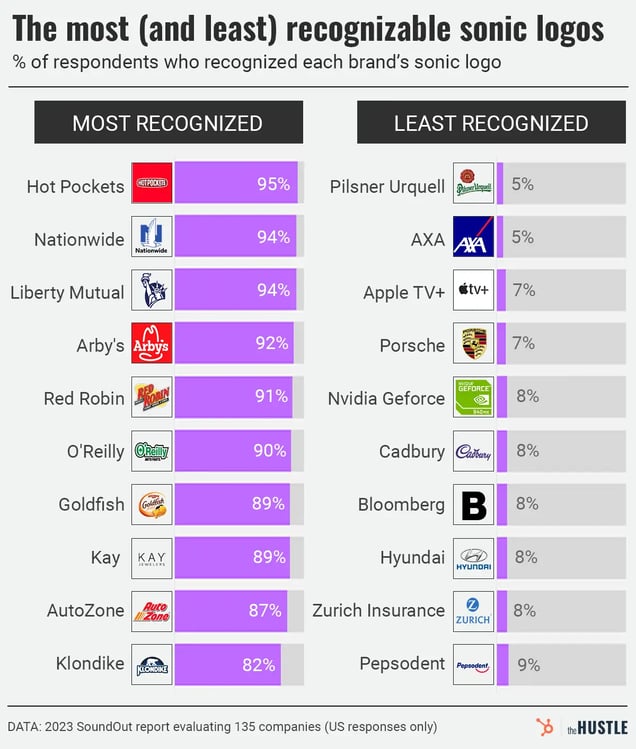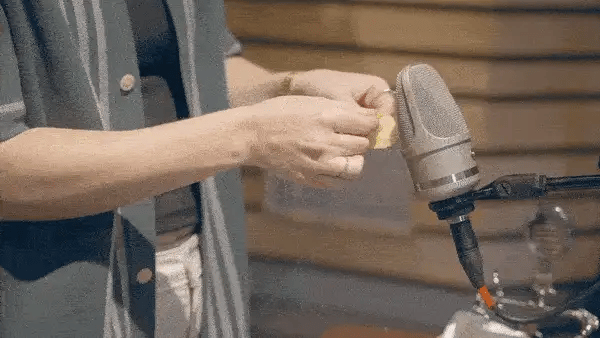Years ago, the Swiss cough-drop maker Ricola faced a major problem as it tried to expand internationally. Almost nobody in America knew the brand existed.

Halls and Vicks dominated the market, accounting for ~67% of all US cough-drop sales in 1987. Ricola, which entered the US in the mid-1980s after decades of crafting herb-based lozenges in the Alps, was a non-player.
So Ricola brought in a yodeler. And an alphorn player. And in a famous 1994 commercial, they stood in the shadow of the Matterhorn and belted out a sound that echoed through the mountains.
RI-CO-LAAAAA!
Soon, the brand’s jingle, or sonic logo, was everywhere:
- On American playgrounds, where ’90s kids shouted “RI-CO-LAAAAA” from the top of jungle gyms
- On the ski slopes, where fathers made countless yodeler dad jokes
- In symphonies, which Ricola sponsored to further link its brand with music

The alphorn. (Picture Alliance/Getty Images)
By 2005, Ricola was the second-leading cough-drop maker in the US, trailing only Halls. The company remains a top seller today, using the same sonic logo.
“They’ve basically carpet-bombed the market,” David Courtier-Dutton, CEO of the sonic brand consulting company SoundOut, said of Ricola, using advertiser lingo for a company that has achieved widespread awareness.
Lately, an increasing number of brands have tried to take the Ricola route: using our ears to develop loyalty and gain market share. Netflix has “ta-dum.” Liberty Mutual has “Liberty, Liberty, Liiiberty.” Other insurance companies have a bevy of sonic logos.
In a world of increasing distractions, experts believe audio is an ideal form of communication, and some companies spend hundreds of thousands of dollars to develop a sonic logo, essentially a soundtrack for a brand, and then far more to publicize their logo to the world.
But for every Ricola, there’s a litany of sounds that nobody recognizes. Sonic logos can increase awareness and drive sales, but companies hoping for a bold audio identity often create a sound that falls flat.
From jingles to sonic logos
Before anyone talked about audio logos, sonic brands, sonic logos, or — cringe — “sogos,” there were jingles. Wheaties is usually recognized for coming up with the first, a barbershop-quartet ditty that saved the product from being phased out of existence.
Jingles were ubiquitous for decades before dying out in the early 2000s. But in the last two decades audio branding has taken on new life — usually as short, catchy bursts, often called sonic logos. (Some consider sonic logos to only be short wordless melodies, unlike the lengthier, traditional jingles of the past; others lump traditional jingles and sonic logos together because they often share similar characteristics.)

Made Music Studios shows how it tests ideas for sonic logos in this video. (The Hustle)
NBC developed a short audio logo with its chime sound in the 1920s. McDonald’s and Intel helped shape sonic logos for the modern era.
- McDonald’s bridged the traditional jingle/modern sonic logo sound with “Ba da ba ba ba: I’m lovin’ it.” The logo has been credited with helping the restaurant chain resuscitate a flagging stock.
- Intel’s four-note bong offered a modern twist to a jingle — a lyric-free sound that was further popularized by Netflix.
According to Courtier-Dutton, a relatively small share of major companies, ~10%, have sonic logos. But he estimates the number has increased by ~3-4x in the last decade. SoundOut has analyzed data from thousands of consumers to produce widely cited reports about sonic branding in 2021 and 2023.
Experts say sonic logos can tap into the power of music to evoke memories and emotions and imbue a brand with personality, leading to stronger engagement and recognition between the brand and customers. Companies believe these relationships lead to greater sales.
“You’re trying to get the consumer who’s standing in the aisle in the store — and you have all these choices, and you don’t know what to choose — you want them to be able to call upon something that they’ve heard or seen,” said David Allan, a professor at St. Joseph’s University and author of Super Sonic Logos: The Power of Audio Branding.

The Hustle
Sonic logos are also harder to avoid than visual advertising.
“You can shut your eyes,” noted Laurence Minsky, co-author of Audio Branding: Using Sound To Build Your Brand, “but you can’t really shut your ears.”
But the reason for the rising popularity of sonic logos may be simpler than that. Americans face a barrage of choices, and most of them are variations of the exact same thing with minimal difference in taste, functionality, or quality (State Farm vs. Farmers Insurance, Burger King vs. McDonald’s).
Besides using a sonic logo, Courtier-Dutton says, “there aren’t many options [for standing out] apart from [making] a product no one else has got and can’t copy.”
Made Music Studios recently worked with Ruffles on a sonic logo. The texture and taste of the company’s chips are negligibly different from the chips of its competitors (Ruffles and Lay’s Wavy even have the same parent, PepsiCo). But Ruffles could sound different.

Made Music Studios tests out the sound of a Ruffles chip. See the full video here. (The Hustle)
Made Music Studios tried several approaches to come up with an ideal crunch for a Ruffles sonic logo: small crunches and medium crunches, crunches that emulated the rise and fall of chip’s ridge texture, crunches made when the chip is turned sideways.
They settled on a small crunch and a medium crunch combined with kick drums and a brass sound.
“If you’re a brand and you want to stand out, it’s such a great place to put your footing,” said Broox Carmona, a music producer with Made Music Studios, “because you want people to recognize you.”
But average consumers often struggle to recall sonic logos.
The difficulty of recognizing lyric-free sounds
Whenever you log into Netflix, its “ta-dum” sonic logo reminds you that a mountain of content is about to appear on your screen. The sonic logo is distinctive and harsh (like “somebody is going to stab me in the back,” says Courtier-Dutton) and contains little of the DNA of a traditional jingle: The company’s name is not even mentioned.
For Netflix, the sonic logo has been a massive success. SoundOut found the company had a recognizability rate of 81% in its 2023 report.
But Netflix is more of an exception than a rule.
- The attribution rate or recognizability rate (i.e., the ability of somebody to hear a sonic logo and correctly identify the company) for 89 out of the 135 brands examined in SoundOut’s 2023 report was less than 33%. The companies with low attribution rates included huge brands like Mastercard (14%), which went to great lengths in 2019 to market a new sonic logo and audio strategy.
- The vast majority of companies with new sonic logos, those less than two years old, had recognizability rates of less than 20%. One exception was TikTok, which clocked in at 34%. (Another report, by the media insights company Kantar, found that TikTok’s recognizability rate was 52% less than a year after the launch of its sonic logo.)
One reason for recall problems? Many companies, like Mastercard, have emulated Netflix by using wordless sonic logos composed entirely of sound effects or music rather than logos announcing the company’s name (in a fashion rooted to jingles of yore).

The Hustle
Based on data collected by Courtier-Dutton and SoundOut, these non-lyrical logos are less effective, with survey respondents roughly half as likely to recognize a company if its name isn’t included in the sonic logo. Of the top 20 most recognized sonic logos in SoundOut’s 2023 survey, 18 featured the name of the brand being sung or spoken. (The two exceptions were the “ta-dum” of Netflix and “pizza pizza” of Little Caesar’s.)
“The reason for that is obvious: You hear the brand name and you associate it with the (musical) notes,” said Steve Keller, sonic strategy director for SXM’s Studio Resonate.
SoundOut has also discovered that creating a distinctive-sounding logo, a la Netflix, isn’t always helpful, either, finding no correlation between distinctiveness and recall. That’s especially bad news for financial companies, Courtier-Dutton says, which provide near-exact services and have attempted to distinguish themselves with unique audio logos.
“In reality, it hasn’t worked that well,” he said. “They’re still boring.”
Courtier-Dutton believes companies should instead focus on two other characteristics: melodic sounds and repetition.
- Pleasant-sounding melodies are more likely to get stuck in someone’s head, similar to pop songs.
- Companies must strategically incorporate their sonic logo into nearly everything they do, and most companies typically use their sonic logo occasionally, Courtier-Dutton said. During the last Super Bowl, according to the sonic branding firm Amp, 16 companies with sonic logos paid for commercials; 11 of them actually used their sonic logo in their ad.
Netflix repeatedly uses its sonic logo. It’s the same strategy employed by Ricola.

Ricola originated in Switzerland in 1930 and began a US expansion in the 1980s. (Ullstein Bild/Getty Images)
Nearly 30 years later, its advertisements always feature the yodeler/alphorn sonic logo, which seems to be permanently lodged in the country’s brains. (Maybe a little too lodged: An Instagram from the satirical website Reductress featured an alphorn player with the tag line “How to Signal It’s Time for Sex by Blowing the Ricola Horn.”)
Thanks to its sonic branding efforts, the company’s recognizability continues to rise — to 67% in 2023, according to SoundOut’s reports.
Ricola, which did not respond to an interview request, has introduced new flavors and slogans and used CGI mountain men, but its sonic logo has stayed the same since the days everybody just called it a jingle.
And why change? That logo has the defining characteristic that every brand aims for but less often reaches: It gets stuck in your head.
Dylan Barth and Taryn Varricchio contributed reporting to this story.

